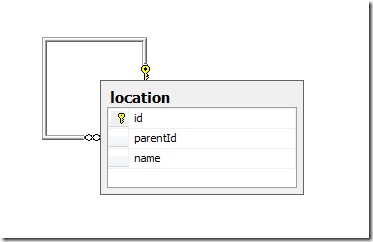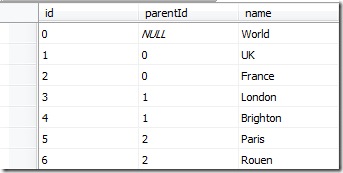It's amazing how things can pass you by. I only found out about the recursive power of the T-SQL 'with' statement today. With it you can easily write a Fibonacci sequence generator:
with fib(a, b) as ( select 0, 1 union all select b, a+b from fib where b < 100 ) select a from fib
Here's the output:
a ----------- 0 1 1 2 3 5 8 13 21 34 55 89
It really comes into its own when you've recursive structures such as a tree in your schema. Take this extremely typical example: a hierarchy of locations. Each record has a primary key 'id' and a foreign key 'parentId' that references another record in the same table.
Here are some records:
Say I wanted to output all the locations with their level in the hierarchy. Easy:
with locationLevel(id, [name], [level]) as ( select id, [name], 0 from location where parentId is null union all select location.id, location.[name], locationLevel.[level]+1 from location join locationLevel on location.parentId = locationLevel.id ) select * from locationLevel id name level ----------- -------------------- ----------- 0 World 0 1 UK 1 2 France 1 5 Paris 2 6 Rouen 2 3 London 2 4 Brighton 2
Or when I search for a particular location, I want to find all its ancestors:
with locations(id, parentId, [name], targetName) as ( select id, parentId, [name], [name] from location union all select location.id, location.parentId, location.[name], locations.[targetName] from location join locations on location.id = locations.parentId ) select id, [name] from locations where targetName = 'Rouen' id name ----------- -------------------- 6 Rouen 2 France 0 World





1 comment:
Just lovely :) Thanks. I've been trying to get the WITH statement to accept UPDATE statements, seems that it doesn't like it:D
Cheers,
D
http://www.realityinfo.org
Post a Comment